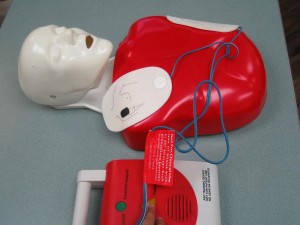Heart diseases continue to be the leading causes of death around the world. Although many individuals suffer from chronic heart diseases and die in a healthcare facility following long-term illness, it is estimated that around 70,000 people die each year due to cardiac emergencies in Canada. It is not surprising to note that most sudden cardiac deaths occur outside the healthcare settings, usually at home. However, deaths due to cardiac emergencies may be minimized through immediate, proper first aid treatment. This is where early defibrillation – delivery of an electrical shock to the heart through the chest wall – comes handy.
People who experience sudden cardiac emergency only have very few minutes in which they can be successfully resuscitated. Studies show that patients of cardiac arrest who were given defibrillation within 3 minutes have a 30% survival rate. The chances of full recovery and survival become more grim for every single minute that passes by. While basic life support, particularly cardiopulmonary resuscitation (CPR), can help improve the outcome of a victim, it can rarely resuscitate a person back to life. Basic life support measures administered on the scene of the emergency should be reinforced with early defibrillation and early medical management.

AEDs Help Improve Outcome of Cardiac Emergencies
There are a number of factors that can affect the chances of survival of victims of an out-of-hospital cardiac emergency. Some of these factors include the person’s medical history, extent of cardiac arrest, prior medical history and other underlying medical conditions.
One of the most significant factors is the time between collapse and defibrillation. Until recently, defibrillation was a skill known only to healthcare providers but with the coming of automated external defibrillators (AED) laypeople can now provide defibrillation to victims of cardiac arrest. The availability of AEDs in public spaces and increasing awareness of public in the use of these emergency devices has significantly improved the survival rate of cardiac patients.
Latest models of AEDs are also getting better and a lot easier to use. There are AEDs that are capable of reading and identifying heart rhythms. These devices are very easy to use, with simple interface and step-by-step instructions. In fact, a properly trained school-age child can use it safely and effectively. You simply have to follow the instructions. Normally, all you have to do is to apply the pad in its designated place and then wait for the device to evaluate the heart rhythm. Once there is a sign of ventricular defibrillation, the AED automatically administers electrical shock to the heart.
The development of AEDs has significantly reduced the response time for cardiac patients and has made the goal of early defibrillation achievable. This has obviously led to improved emergency care for cardiac patients. To learn more about how to deal with cardiac emergencies, it is best to complete a first aid training course with organizations such as the workplace approved.
Related Video
http://www.youtube.com/watch?v=GyZS9CYEFDk
